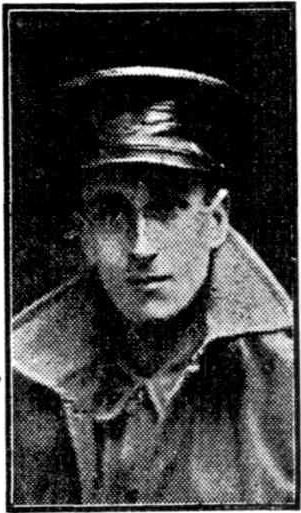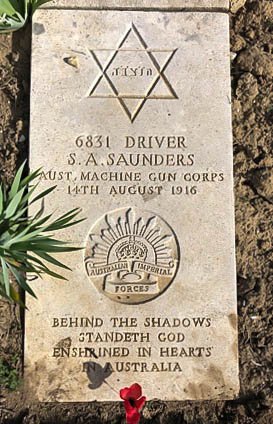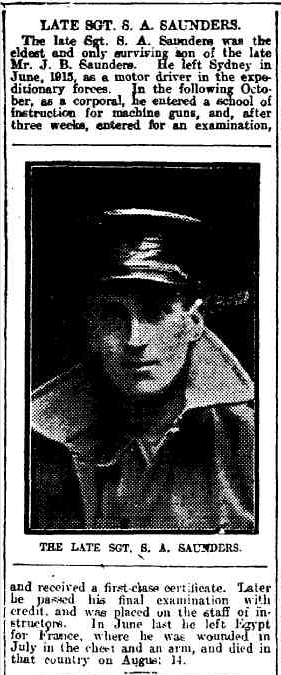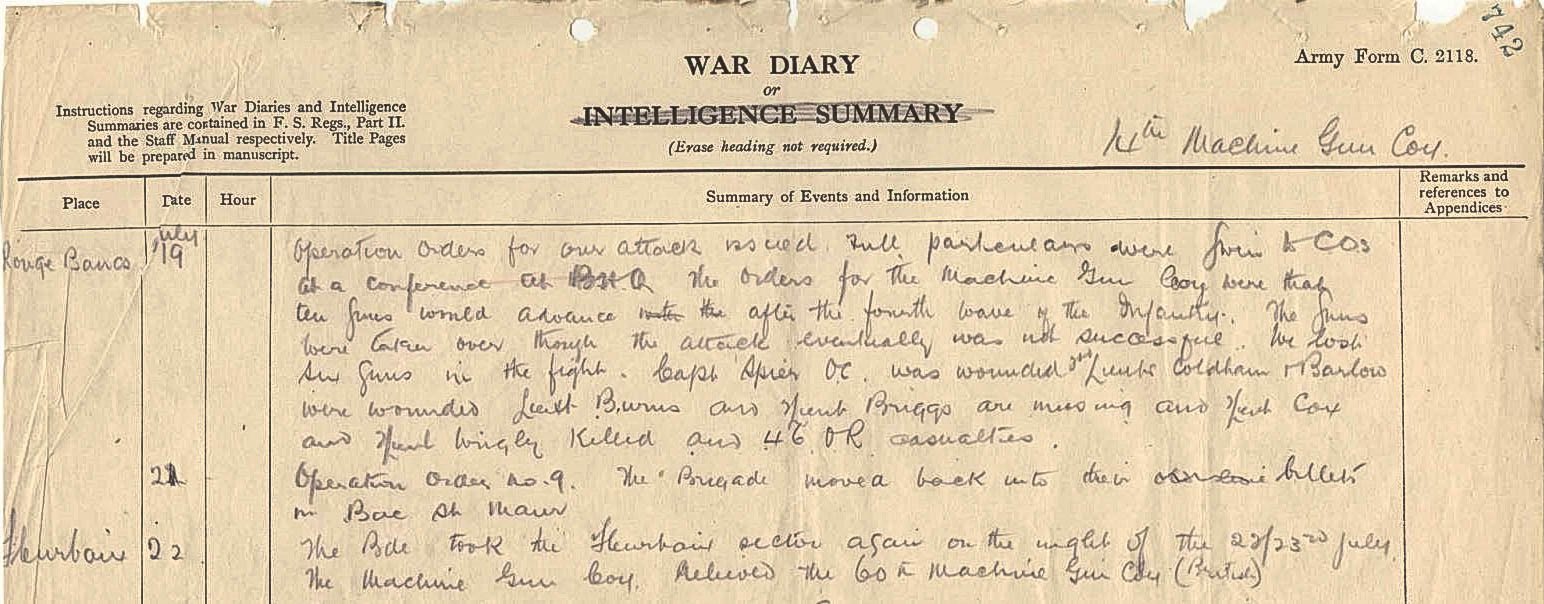
Samuel Archie SAUNDERS
Eyes brown, Hair brown, Complexion fair
SAUNDERS, Samuel Archie
Story text (with minor edits and additions) is reproduced with permission from the copyright holders, the Australian Jewish Historical Society on behalf of Peter M. Allen.

Samuel Archie Saunders was born 6 February 1886 in Kent Town, Adelaide, SA, to Rachel (née Solomon) and John Barnett Saunders. Known as Archie, he attended the Pulteney Street (Anglican) School, and being dextrous with his hands, was one of the first to be apprenticed for four years to F. Ochernat as a fitter and motor mechanic.
After his father passed away in 1910, Archie moved to Sydney, where apparently, he became friends with a Miss L. McKim.
On 6 January 1915 and slightly understating his age as 27, Archie enlisted in the AIF at Liverpool, NSW, in the 8th Australian Army Service Corps, 6th Reinforcement, as No. 6831 Driver Samuel Archie Saunders, noting his mother as next-of-kin and religion ‘Jewish’.

Sailed for Egypt
On 16 June 1915 they embarked aboard HMAT A63 Karoola from Sydney for Egypt, where he was attached to the 2nd Brigade Ammunition Column from August 1915. Subsequently, as reported by the Adelaide Observer and was placed as a Corporal in the Machine Gun Staff of the Imperial School of Instruction at Zeitoun:
“he entered a school of instruction for machine guns, and, after three weeks, entered for an examination, and received a first-class certificate. Later he passed his final examination with credit”
Archie’s request to join a combat unit was implemented at Tel el Kebir in April 1916, when he was transferred to the 14th Brigade Machine Gun Company and promoted to sergeant.
.
The Battle of Fromelles
The 14th MG Coy sailed from Alexandria on 18-19 June 1916 on HMT Knight Templar and a few on HMT Canada – including portentously Archie - arriving seven days later at Marseilles, where they entrained to Thiennes, in the north of France, 20 kilometers west of Lille, for deployment on the Western Front.
Late in the evening of 10 July, half of the company entered the frontline at Fleurbaix, and by the next midnight they completed the relief of the 12th MG Coy.
Poor visibility due to haze again delayed the artillery barrage and infantry attack on the morning of 19 July, when the 14th MG Coy Diary (AWM) records that the Officer in Charge, Captain Spier, received their operational orders in a conference led by Colonel H. Pope at his Brigade Headquarters: ten guns would advance after the fourth wave of the infantry.
The two leading waves of the 53rd and 54th Battalions had already lost over sixty men, including commanders and their seconds-in-command of three companies, from the German artillery fire and inaccurate Australian shells, before leaving the forward trenches at 5:43 pm, and were caught by enfilade machine gun fire from the Sugarloaf as they emerged from the sally-ports.
Yet, many of the remaining assault troops still managed to advance “about 300 yards to our front … and form up in front of the enemy’s parapets”, then overwhelm the German trench. The machine gun company also “succeeded in pushing across No-Man’s Land … and (the ten guns) were soon located in favourable positions in the captured ground.”[[]]
Many officers were killed or wounded, as Patrick Lindsay in his book Fromelles notes:
“The Germans set up a line of riflemen near the area known as Rouges Bancs in front of the 14th Brigades’ line. They were tasked with picking off the Australian officers as they led their men across the open ground. The tactic soon began to pay rich dividends.”
But, although some men advanced too far and others retired to their lines, by 6:30pm the 14th Brigade had established a position within its section of captured German trenches. Shortly afterwards, communication trenches and saps were constructed, to provide supplies and reinforcements.
However, from 11:00pm the Germans mounted a series of counterattacks, many involving bombing raids, including from both flanks, where the advance of the adjoining brigades had been less successful, and breaking links to the Australian lines - also resulting in carrying parties staying to join the fight. With fewer reinforcements and supplies reaching the remnants of the 14th Brigade as the night progressed, the situation continued to deteriorate, the trenches were flooded from the Laies Brook, and they were close to being surrounded.
At 6:30am the next morning, Lt. Col. Cass, CO of 54 Bn, began to organise a rearguard to cover the retirement of the brigade, including a plan to save the precious machine guns by sending them back one at a time. In one incident, the 14th's machine-gunners fired on their own troops, who - in the dusk - had been mistaken for Germans"
The order to withdraw was finally received at 7:50am. It had taken eight runners to get the message across the inferno that was No Man’s Land: the carrier pigeons had duly taken messages to Brigade HQ, but they would not fly back. Many defenders remained, whilst others fought their way out, often in hand-to-hand fighting, back to the Australian lines: resulting in heavy casualties of killed, wounded, or captured men.
As the 14th MG Coy diary summarises:
“the attack eventually was not successful. We lost six guns in the fight. Captain Spier OC was wounded, 2/Lieuts Coldham and Barlow were wounded. Lieut Burns and 2/Lieut Briggs are missing and Lieut Cox and 2/Lieut Wrigley killed and 46 Other Ranks casualties.”
Indeed, Lt Robert Burns, heir to the Burns Philp shipping fortune, had refused to surrender. he smashed his machine gun and, with a few of his surviving men, tried to make his way back. His body was never found. Overnight, of the company’s 150 or so men, 17 were killed in action, with dozens wounded – still a lower rate than the brigade’s 1,717 casualties and the 5th Division’s total of more than 5,500.
One of those wounded as the Australians withdrew on the morning of 20 July, was Sergeant Samuel Archie Saunders, hit by gunshot to the arms and chest. Unlike many men who were left in No Man’s Land, he was lucky to be retrieved and taken by stretcher bearers of the 14th Field Ambulance to one of the twelve Regimental Aid Posts, six of which had been moved forward to 500 yards behind the assault battalions’ lines. They were overwhelmed with wounded, dying and dead – reflecting the situation in the communication trenches and No Man’s Land through which they pierced. The indescribable scenes of carnage continued over the ensuing days, when many men gave their lives rescuing comrades, as enemy fire persisted. Although agreed to by the Germans, the request of Australian officers in the field for a ceasefire to clear the battlefield of casualties was rejected by McKay – hence his later nickname, ‘Butcher McKay’.
In what became known as the Battle of Fromelles, author Robin S. Corfield (Don’t Forget Me Cobber, the Battle of Fromelles, 19/20 July 1916: an inquiry) confirms:
“only the 14th Brigade (all NSW) - in the centre position of the Australian line - could be described as being successful”. But the battle was a disaster, resulting in extremely heavy allied casualties, including over 2,000 Australian dead: still the worst 24 hours in Australian military history.
On 21 July, “the Brigade moved back into their billets at Bac-Saint-Maur” and then, “took the Fleurbaix sector again on the evening of 22/23rd July.” The next day, Saunders was evacuated from No. 1 Canadian Casualty Clearing Station to a base hospital."
Those left behind

On 29 July, Rachel Saunders received a telegram that her son was dangerously ill, and she advised Miss McKim in Sydney, both cabled the Army. Despite seeing a newspaper report of Archie’s death, Rachel received telegrams on 8 and 16 August that his condition was “improving” but, as noted in his record, Sergeant Samuel Archie Saunders had:
"Died at 11:15am on 14 August 1916 from a ‘gun-shot wound penetrating chest’, in Ward 4, aged 29."
Agonisingly, Rachel did not receive confirmation of his death for at least another month.
Archie Saunders’ Red Cross Wounded & Missing file reflects those conflicting reports of his condition. On 15 August AIF Headquarters, Horseferry Road, London, certified that he was “Removed from the Dangerously Ill List, and transferred to Base 1st Canadian Casualty Clearing Station 30/7/16.” Yet, Sister-in-Charge E. M. Thorold, of 13th General Hospital, Boulogne, replied to the Red Cross on 23 September 1916:
”Your letter (of 18 September 1916) re Sgt. Samuel A. Saunders … has been handed to me to answer, as he was a patient in my ward. He was admitted to this hospital on July 25th. I have already written to his relatives in Australia as I do to [relatives of] all my seriously wounded patients under my care. He was dangerously wounded in the chest. An operation was performed but proved unavailing and he gradually grew worse and died on August 14th. I have written to his mother and have also since sent her a photograph of the cemetery of Boulogne (Military Section) where he is buried. I think this is all I can tell you concerning him.”
In this story, as with so many Fromelles stories, the human tragedy did not end with Archie’s death. To his family, the emotional turmoil was excessive, as hope was nurtured, only to be dashed. One can only say, that every member of Archie’s family, Miss McKim and his friends carried the scars of false hope forever.
Rachel received a package containing Archie’s personal effects in April 1917 at her home in St Peters, Adelaide. His service record (page 5) also has a hand-written note that a “Photograph (was) sent by DGRE to Miss McKim of ‘Lota’ Ocean Street, Woollahra.” (DGRE refers to Director Graves Registration and Enquiry)

Sergeant Archie Saunders commemorated
Sgt Samuel Archie Saunders was buried in Boulogne Eastern Cemetery, Boulogne, Nord Pas de Calais, France, and his headstone (picture below, showing incorrect rank as ‘Driver’ cf. ‘Sergeant’) is inscribed with the epitaph requested by his mother, Rachel:
BEHIND THE SHADOWS STANDETH GOD ENSHRINED IN HEARTS IN AUSTRALIA
In Adelaide’s West Terrace Cemetery, on the Saunders family memorial to her youngest son Braham, and husband John, Rachel also added text commemorating her only surviving son - until 14 August 1916 - Archie:
ONE WHO HEARD THE CALL OF GOD AND ANSWERED IT


Links to unofficial records
Links to Official Records
The Fromelles Association would love to hear from you

Contacts
(Contact: carla@fromelles.info or geoffrey@fromelles.info).
(Contact: army.uwc@defence.gov.au or phone 1800 019 090).
Donations
If you are able, please contribute to the upkeep of this resource.
(Contact: bill@fromelles.info ).

